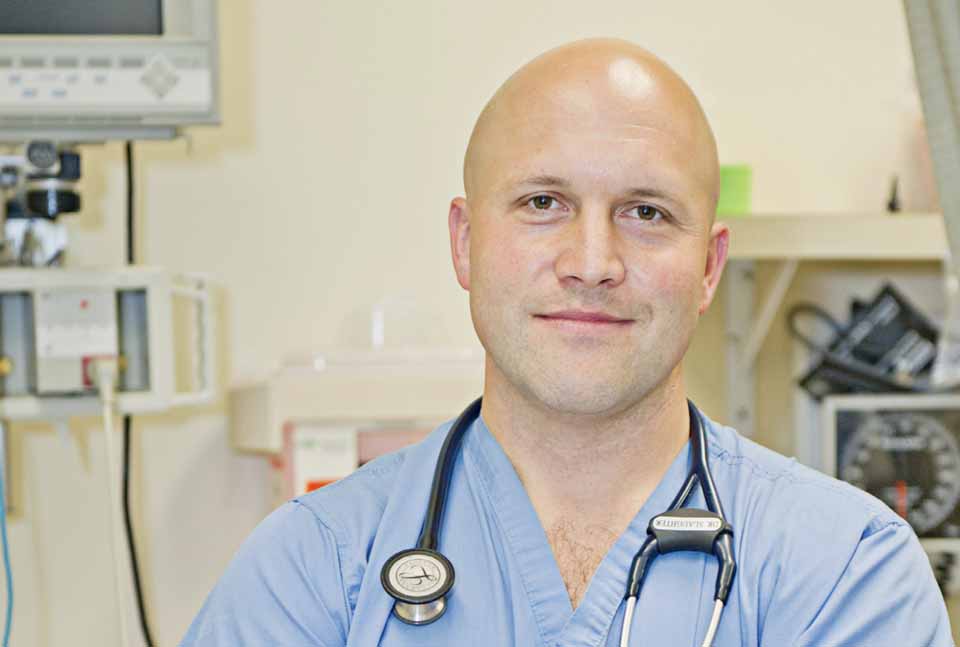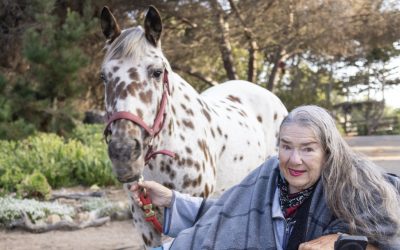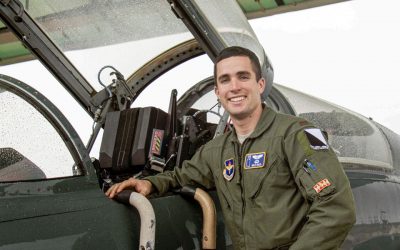Today is Friday, April 10, 2020. Let us start with that in mind because every article and news-feed update of late is subject to being massively out of date in less than three days. In fact, there’s been difficulty beginning any story in the last two months without invoking some level of overwrought cliché. Everyone and their misinformed uncle has an opinion to share. And after two weeks of regularly tuning in to the internet streams, between long periods of strenuous exercise to keep fearful thoughts at bay, and incidentally, muscles from decaying, this journalist was about to chuck the screens for good and begin a life of hermetic isolation reminiscent of another ancient custom. Then the thought occurred that there was at least one person in 15 years of cataloged local contacts worth calling for a check-in.
Dr. Clint Slaughter—who is, incidentally, the CEO of a local business heavily impacted by the economic halt imposed by COVID-19—is an emergency room physician at San Luis Obispo’s French Hospital Medical Center, Arroyo Grande Community Hospital, and Mee Memorial Hospital in King City. He’s also a community activist of long-standing. Over the years, I’ve run into Dr. Slaughter at community events and through his work with SLO MakerSpace. His innate curiosity about the world, and his drive to understand the mechanics of a situation so that it can be improved upon later, have stood out as distinguishing characteristics.
While it’s dangerous to speculate on what core drives others may possess which we do not, it seems likely that Dr. Slaughter’s seemingly limitless font of energy stems more from a disciplined inability to waste his time than from the Energizer Bunny I spotted with him at a Softec Robotics Fair some years ago. (Although that latter theory may bear out eventually.)
Contacting the good doctor with questions about how he was experiencing life in the ER at the moment, pulling roughly 16 shifts a month among the three hospitals, his response included his primary concern that too many of his would-be patients are staying at home rather than coming in for treatment.
“It’s actually very interesting,” Dr. Slaughter began. “What we’re seeing locally has been something of a success story it seems, in that we are flattening out the curve. We are seeing COVID cases but it’s really hard to estimate how many we actually have in the County because we have such limited testing. That’s one of the things we’re actively working on: To get to the point where we can test people with any symptoms at all or even no symptoms. At the moment, the 100 or so confirmed cases are the ones that we were able to make sure got tested.”
“One of the problems we’re having in the ER right now,” he continued, “is that it’s actually not very busy. People are staying away from the ER for anything that’s a [non-life threatening] emergency because they’re afraid of getting COVID. The drawback to that is that we’re having people not come in to see us when they’re actually sick, and by the time they do come in they’re much sicker than they would have been had they sought treatment; things like appendicitis. And it’s harder to treat their emergent issues when we do see them, especially if they have lung issues like chest pain and they’re staying home.”
While it’s dangerous to speculate on what core drives others may possess which we do not, it seems likely that Dr. Slaughter’s seemingly limitless font of energy stems more from a disciplined inability to waste his time than from the Energizer Bunny I spotted with him at a Softec Robotics Fair some years ago. (Although that latter theory may bear out eventually.)
Contacting the good doctor with questions about how he was experiencing life in the ER at the moment, pulling roughly 16 shifts a month among the three hospitals, his response included his primary concern that too many of his would-be patients are staying at home rather than coming in for treatment.
“It’s actually very interesting,” Dr. Slaughter began. “What we’re seeing locally has been something of a success story it seems, in that we are flattening out the curve. We are seeing COVID cases but it’s really hard to estimate how many we actually have in the County because we have such limited testing. That’s one of the things we’re actively working on: To get to the point where we can test people with any symptoms at all or even no symptoms. At the moment, the 100 or so confirmed cases are the ones that we were able to make sure got tested.”
“One of the problems we’re having in the ER right now,” he continued, “is that it’s actually not very busy. People are staying away from the ER for anything that’s a [non-life threatening] emergency because they’re afraid of getting COVID. The drawback to that is that we’re having people not come in to see us when they’re actually sick, and by the time they do come in they’re much sicker than they would have been had they sought treatment; things like appendicitis. And it’s harder to treat their emergent issues when we do see them, especially if they have lung issues like chest pain and they’re staying home.”
As of the time we spoke, Dr. Slaughter told me that local hospitals were supplied well enough and had treatment protocols in place to separate potential COVID cases from those coming in for other emergencies. Personal Protective Equipment (PPE) was being used properly and effectively without the reliance on lesser means of protection which facilities on the East Coast of the United States were currently experiencing.
“You know my wife and I talked about that, too,” said Dr. Slaughter. “How am I going to make sure it doesn’t come home with me?” His wife, Laura, is a nurse with more than a passing familiarity with the risk factors associated with a highly contagious new virus. His work shoes now live in the garage, and his workplaces have been able to provide scrubs that stay at “the office” where he showers and changes before going home, a luxury that has not always been the norm for healthcare workers.
But work and home life are interacting in other ways too as their children have joined their peers in sudden adaptation to homeschooling. “All the hands-on stuff has obviously come to a hold,” he explained. “But we [SLO MakerSpace] are a vendor for educational enrichment programs with the [San Luis Obispo County Partners in Education] and those programs have really taken off,” he continued. “Right now I’ve essentially commandeered our 3D-printers at the MakerSpace while physical operations are closed, and I’ve been 3D-printing medical equipment for the last two weeks.”
The MakerSpace is organizing their mask-making efforts through ServiceforSLO.com, with their print files made available on several open-source distribution platforms. Working with Cristian Sion, a Cal Poly student in materials engineering and manufacturing engineering, and Jeremy Ralston, facilities engineer with the San Luis Obispo Surgery Center, Dr. Slaughter has been printing holders for the much talked about N95 mask, which is rated to block 95 percent of very small (0.3 micron) particles.
Officially submitted to the U.S. Department of Health and Human Services for review and recommendation, the SLO Respirator design is an open-source project with improved airflow and sanitization abilities on the traditional mask filter holders, currently in short supply.
“They’re not being used at the moment because we’re not in a situation of critical low supply of approved equipment, but we’re getting ready,” Slaughter said. “I’m really concerned about some of the recommendations coming out on basic face coverings that suggest using something like a bandanna. Is that a recommendation based on effectiveness or because people don’t have the supply? Any mask with a filter is going to be better than a bandanna. The cheapest masks available are estimated to give you 40-60 percent protection, and something with a HEPA filter is going to be better than that; not N95 quality but better than what people have been doing.”
Requirements in a medical setting and what residents should worry about in public are very different circumstances, he added.
“You know my wife and I talked about that, too,” said Dr. Slaughter. “How am I going to make sure it doesn’t come home with me?” His wife, Laura, is a nurse with more than a passing familiarity with the risk factors associated with a highly contagious new virus. His work shoes now live in the garage, and his workplaces have been able to provide scrubs that stay at “the office” where he showers and changes before going home, a luxury that has not always been the norm for healthcare workers.
But work and home life are interacting in other ways too as their children have joined their peers in sudden adaptation to homeschooling. “All the hands-on stuff has obviously come to a hold,” he explained. “But we [SLO MakerSpace] are a vendor for educational enrichment programs with the [San Luis Obispo County Partners in Education] and those programs have really taken off,” he continued. “Right now I’ve essentially commandeered our 3D-printers at the MakerSpace while physical operations are closed, and I’ve been 3D-printing medical equipment for the last two weeks.”
The MakerSpace is organizing their mask-making efforts through ServiceforSLO.com, with their print files made available on several open-source distribution platforms. Working with Cristian Sion, a Cal Poly student in materials engineering and manufacturing engineering, and Jeremy Ralston, facilities engineer with the San Luis Obispo Surgery Center, Dr. Slaughter has been printing holders for the much talked about N95 mask, which is rated to block 95 percent of very small (0.3 micron) particles.
Officially submitted to the U.S. Department of Health and Human Services for review and recommendation, the SLO Respirator design is an open-source project with improved airflow and sanitization abilities on the traditional mask filter holders, currently in short supply.
“They’re not being used at the moment because we’re not in a situation of critical low supply of approved equipment, but we’re getting ready,” Slaughter said. “I’m really concerned about some of the recommendations coming out on basic face coverings that suggest using something like a bandanna. Is that a recommendation based on effectiveness or because people don’t have the supply? Any mask with a filter is going to be better than a bandanna. The cheapest masks available are estimated to give you 40-60 percent protection, and something with a HEPA filter is going to be better than that; not N95 quality but better than what people have been doing.”
Requirements in a medical setting and what residents should worry about in public are very different circumstances, he added.
“Treating someone with a respiratory disease necessitates procedures which can aerosolize the virus. That’s different from moisture droplets in the environment. It’s performing procedures that can cause it to spread while we’re attempting treatment. That’s why positive pressure masks and PPE are so important. And we’re still figuring out the best treatment too. Things like nebulizers and inhalers, because once the patient is placed on a ventilator they’re going to be on it for the duration, and that could be three weeks. This is not influenza; it’s a very different kind of virus. There is no vaccine, and when we do get one, the immunity it provides is unknown.”
While everyone is in wait-and-see mode, Dr. Slaughter encourages those with medical needs to seek treatment rather than attempting to tough things out on their own.
“Come in and we’ll take care of you,” he said. “I’m not getting tired of talking about COVID because this is a fascinating problem that we’re trying to solve. … The hardest part for me has been keeping up on all the news and the podcasts and information on how people are fighting something so new.”
Those of us still well might check out helpslo.com, a forum for community volunteerism, and the aforementioned serviceforslo.com. And those in possession of a 3D printer might study the designs offered at slorespirator.org.
Meantime, Friday April 10th is a gorgeous day on the Central Coast, following some much-needed rainfall. Yet, we are reminded to stay home, self-isolate, and restrict non-essential travel. The scientific consensus is that it’s best to cover our faces when we do venture out and wear gloves when handling objects that others have touched.
Today, in their absence, I am struck by the value of such simple gestures as a smile and a handshake.
While everyone is in wait-and-see mode, Dr. Slaughter encourages those with medical needs to seek treatment rather than attempting to tough things out on their own.
“Come in and we’ll take care of you,” he said. “I’m not getting tired of talking about COVID because this is a fascinating problem that we’re trying to solve. … The hardest part for me has been keeping up on all the news and the podcasts and information on how people are fighting something so new.”
Those of us still well might check out helpslo.com, a forum for community volunteerism, and the aforementioned serviceforslo.com. And those in possession of a 3D printer might study the designs offered at slorespirator.org.
Meantime, Friday April 10th is a gorgeous day on the Central Coast, following some much-needed rainfall. Yet, we are reminded to stay home, self-isolate, and restrict non-essential travel. The scientific consensus is that it’s best to cover our faces when we do venture out and wear gloves when handling objects that others have touched.
Today, in their absence, I am struck by the value of such simple gestures as a smile and a handshake.





